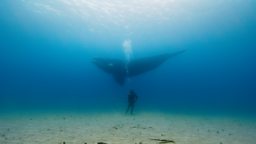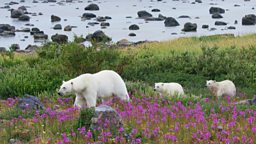Main content
Filming the world's most captivating animals for a spectacular series
From tickling whales to a smashing time with chimps...
The Seven Worlds, One Planet team pick some of their favourite moments from the series.
Antarctica, Southern right whale

Southern right whales are so trusting and curious of humans they would often swim up close to the team. They enjoyed the bubbles that the camera gear expelled, so much so they would stretch out their bellies above us so that the bubbles would hit their undersides giving them a tickle... The difference between a playful dog and a playful whale however is about 60 tonnes so the team had to be very careful!
Asia, snub-nosed monkey

The high mountain ranges in central China are remote and to date have been largely inaccessible to film crews. Yet for hundreds of years stories of the 'Abominable Snowman' have emanated from this region. This is where the story of the Yeti comes from 颅- some kind of strange, scary looking people that nobody knew anything about. In fact the Yeti myth could originate from the golden snub-nosed monkey. They're absolutely incredible because they spend a lot of their time walking upright like we do.
South America, Angel Falls

We wanted to film these mountains called 'Tepui' in Venezuela. They're stunning flat-top mountains and Angel Falls comes off the top of one and that's the largest waterfall in the world. We wanted to use these mountains as a microcosm of South America's richness and uniqueness, by showing that one flat top mountain can be home to more species of plants and animals than in all of Britain... and the very next mountain can have completely different plants and animals.
Australia, cassowary

The cassowary is the world's deadliest bird and it lives in the deep jungle in the north of Australia, which is the oldest jungle on Earth. That jungle was once walked by dinosaurs and basically when dinosaurs became extinct, cassowaries took their place. The females stand about six feet tall, the males more like five feet, but they rear up above head height and they have claws on their feet that are longer than a velociraptor's. They can run up to 30 mph, jump five feet in the air and they can swim. So if you surprise them you're done for; that's why they're the world's deadliest bird.
Europe, wolves

Through our research we found out that wolves in Italy have been hunting right on the edge of mountain villages. We began with a photograph of a wolf that had been taken by a famous photographer, he then suggested a possible location and also told us that he thought that hunts probably happened round about sunset. We sent out a day crew and a night crew, the day crew with very sensitive cameras, the night crew with big long lens thermal cameras that can zoom in right across the valley and punch through darkness, so we were able to film 24/7.
North America, polar bear

To film polar bears hunting beluga whales in the Hudson Bay we went out each day on a small metal boat. We used to anchor the boat so that we wouldn't drift on the tide and film the polar bears waiting for the belugas to arrive. But on one occasion the polar bear decided that playing with our anchor line was more fun than waiting for belugas. The bear lifted our anchor off the bottom and started playing with our anchor rope. He did eventually get bored but by that time we had drifted onto a rock and got stuck. We had to wait for the polar bear to leave before we could jump into the freezing cold water and free ourselves from the rocks!
Africa, chimpanzee

We were out on location for about a month for this sequence. It was a case of working with a group of scientists who'd been studying the chimpanzees for upwards of 40-odd years. They were the ones who were able to take us to a group of habituated chimpanzees, and then we had to move through the jungle following these chimpanzees 颅- they'd go elegantly and quietly while we'd thrash around with all our equipment.
Watch the most spectacular moments from the Seven Worlds, One Planet series in a special programme, Continents of Wonder, on New Year's Day, 大象传媒 ONE at 1:05pm, or catch up on all seven episodes in the series box set, available now on iPlayer.
